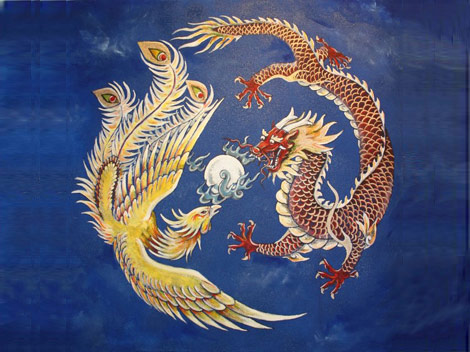
In China, the fictional dragon and the phoenix are traditional animals that symbolize auspiciousness. Along with the kylin and tortoise, they were known as the "Four Supernatural Spirits."
According to ancient records, the dragon appeared as a composite of many animals, such as the snake, alligator and lizard -- long or short, small or huge, hidden yet active. It could also inhabit any place -- from the greatest heights to the lowest depths. Traveling between the skies and the earth, dragons were considered the heads of heavenly deities and governors of rainfall in Chinese culture. During times of drought, dragons could create precious water and in times of flood they stopped the rain and cleared the skies. As kings of the waters, dragons lived in dragon palaces under the ocean.
Dragons are deeply rooted in Chinese culture: Chinese people often consider themselves "the descendants of the dragon" and Chinese emperors thought they were real dragons and the sons of heaven. Thus, their beds were appropriately called "dragon beds," their throne, "dragon seat," and their ceremonial robes, "dragon robes." Also, dragons, which are a symbol of imperial power, can be spotted on many buildings in the imperial palace. (Dragon screens are an important part of this dragon culture.)
The dragon also plays an important part in Chinese festivals. The dragon dance has a long history, dating back to the Song Dynasty (960-1279). The Dragon Boat Festival is almost a purely dragon-related festival, which is now internationally recognized.
The Chinese phoenix, likewise, exists only in legends and fairy tales. The phoenix was commonly referred to as the "King of Birds." As sovereign of all birds, it has the head of a golden pheasant, a parrot's beak, the body of a mandarin duck, the wings of a roc, peacock feathers and the legs of the crane. With its elaborate beauty, it reigns over the feathered world. An early design of the phoenix is depicted on a silk painting (right) discovered in a tomb of the Warring States Period (475-221BC) near Changsha, Hunan Province . As a supernatural bird, the phoenix embodies the five virtues of benevolence, righteousness, propriety, wisdom and sincerity. As such, it cannot harm either a single insect or blade of grass. It perches itself only on the finest firmiana tree, eating and drinking nothing but bamboo seeds and sweet spring water.
Since the dragon and the phoenix usually serve as auspicious symbols, any reported sightings of a dragon or phoenix were considered extremely auspicious, heralding a glorious period of peace and prosperity for the people and the country. This is reflected in the Chinese saying: "When the dragon soars and the phoenix dances, the people will enjoy happiness for years, bringing peace and tranquility to all under heaven."
Besides, since both figures possess a reserved yet elusive spirit, capable of freely transcending the boundaries of heaven and earth, they were often referred to as metaphors in ancient China for gentleman and sages. For example, Confucius reportedly compared Laozi , famous philosopher and thinker of ancient China, to a dragon. It is also believed that Laozi compared Confucius' wisdom and grace to the lofty virtues associated with the phoenix. Both of them took benevolence as the ultimate virtue towards the treatment of others.
Highly revered and greatly appreciated, images of the dragon and phoenix appeared on ceremonial jade ornaments and were carved, painted, or sewn onto objects of everyday use to represent reverence for the spirits and fortune. This custom was passed down throughout the ages. From references to the dragon and phoenixes in local festivals and rites to the heights of literature and fine art, they all reveal the glory of these legendary animals.
We recommend:
